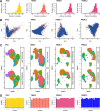Comparative performance of the BGI and Illumina sequencing technology for single-cell RNA-sequencing
- PMID: 33575589
- PMCID: PMC7671348
- DOI: 10.1093/nargab/lqaa034
Comparative performance of the BGI and Illumina sequencing technology for single-cell RNA-sequencing
Abstract
The libraries generated by high-throughput single cell RNA-sequencing (scRNA-seq) platforms such as the Chromium from 10× Genomics require considerable amounts of sequencing, typically due to the large number of cells. The ability to use these data to address biological questions is directly impacted by the quality of the sequence data. Here we have compared the performance of the Illumina NextSeq 500 and NovaSeq 6000 against the BGI MGISEQ-2000 platform using identical Single Cell 3' libraries consisting of over 70 000 cells generated on the 10× Genomics Chromium platform. Our results demonstrate a highly comparable performance between the NovaSeq 6000 and MGISEQ-2000 in sequencing quality, and the detection of genes, cell barcodes, Unique Molecular Identifiers. The performance of the NextSeq 500 was also similarly comparable to the MGISEQ-2000 based on the same metrics. Data generated by both sequencing platforms yielded similar analytical outcomes for general single-cell analysis. The performance of the NextSeq 500 and MGISEQ-2000 were also comparable for the deconvolution of multiplexed cell pools via variant calling, and detection of guide RNA (gRNA) from a pooled CRISPR single-cell screen. Our study provides a benchmark for high-capacity sequencing platforms applied to high-throughput scRNA-seq libraries.
© The Author(s) 2019. Published by Oxford University Press on behalf of NAR Genomics and Bioinformatics.
Figures




References
-
- van Dijk E.L., Auger H., Jaszczyszyn Y., Thermes C.. Ten years of next-generation sequencing technology. Trends Genet. 2014; 30:418–426. - PubMed
LinkOut - more resources
Full Text Sources
Other Literature Sources

